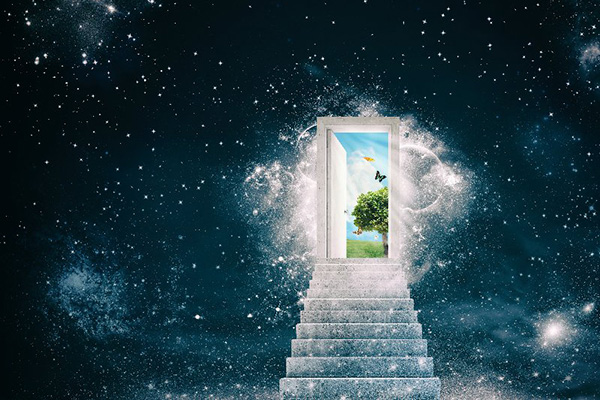The Difference Between ‘Psychic’ And ‘Intuitive’
 The terms “psychic” and “intuitive” are often used interchangeably, but there is a fundamental difference between the two. Understanding this distinction can enhance one’s spiritual practice, deepen your self-awareness, and clarify the role these abilities play in navigating energy, conscious living and spiritual awareness.
The terms “psychic” and “intuitive” are often used interchangeably, but there is a fundamental difference between the two. Understanding this distinction can enhance one’s spiritual practice, deepen your self-awareness, and clarify the role these abilities play in navigating energy, conscious living and spiritual awareness.
The term “psychic” refers to the ability to access information through a special non-physical or spiritual system of perception, more often called the psychic senses or the clair senses. This ability allows a person with psychic ability to perceive or sense information without using the five physical senses. Psychic perception involves tuning into unseen frequencies and receiving impressions that are inaccessible to the five ordinary senses.
Psychic perception therefore involves reaching outward to access information from external sources. This can include tuning into other people’s energies, telepathy, communicating with the spirit realm, exploring the Akashic Records, or channeling from the universal consciousness.
The term “intuitive” refers to a the ability to access information within. Intuitive perception involves connecting with your higher self or soul essence, tapping into the innate wisdom, guidance and truth that resides within you. Unlike the psychic process of acquiring information, intuition is less about “getting” and more about already “having”-a natural inner knowing or awareness that arises effortlessly.
The Ancient Wisdom Of The Two Wolves
 The story of the Two Wolves holds a special place among my childhood favorites. The moral of this Native American wisdom tale, thought to have originated with the Cherokee tribe, serves as a daily guiding light in my life.
The story of the Two Wolves holds a special place among my childhood favorites. The moral of this Native American wisdom tale, thought to have originated with the Cherokee tribe, serves as a daily guiding light in my life.
I must confess, there is some sentimental bias on my part, as this story also brings back lovely memories of my remarkable grandfather, Sequoia, a former medicine man and chief of the Cherokee Nation.
Variations of the story exist in various Native American cultures, and it typically goes like this:
One evening, an old Cherokee is teaching his granddaughter about life and says, “My daughter, a fight is going on inside all of us each day. It is the battle between the two wolves.”
“One wolf is evil — anger, envy, jealousy, sorrow, regret, greed, arrogance, self-pity, guilt, resentment, inferiority, lies, false pride, superiority, and ego. The other wolf is good — joy, peace, love, hope, serenity, humility, kindness, benevolence, empathy, generosity, truth, compassion, and faith.”
The granddaughter thinks about it for a minute and then asks her grandfather, “Which wolf will win?”
Follow Your Passion And Truth
 In Native American tradition, human existence and well-being is based on the Medicine Wheel, also known as the Sacred Hoop, that consists of the Four Directions, Father Sky, Mother Earth, and the Spirit Tree. Together these ‘spokes’ of the wheel honor all aspects of human existence, growth, balance, and well-being: physical, emotional, mental, and spiritual.
In Native American tradition, human existence and well-being is based on the Medicine Wheel, also known as the Sacred Hoop, that consists of the Four Directions, Father Sky, Mother Earth, and the Spirit Tree. Together these ‘spokes’ of the wheel honor all aspects of human existence, growth, balance, and well-being: physical, emotional, mental, and spiritual.
In each lifetime, we are destined to achieve progress in one or more of these areas until, finally, after many incarnations, all the ‘spokes’ of our wheel are complete – all the way from the inner hub to the outer rim. At that point, we have completed our various missions through many incarnations in a myriad of schoolrooms, and we finally achieve ascended mastery.
When all our spokes are complete, we leave this dense, earthly dimension and arrive at the highest plane of existence, the realm of the Great Spirit, traditionally known as the ‘Hunting Grounds of the Ancestors,’ and since the arrival of Christianity, as ‘Heaven.’
In this state we never need to descend again, and will remain infinitely in the higher dimension. We are liberated from the endless cycle of rebirth and reach a new level of consciousness and enlightened existence, known as nirvana in Buddhism, moksha in Hindusim, and eternal life in Christianity.
As a result, from a spiritual stand-point, we are offered a smorgasbord of options and choices that we may need for our particular journey in this lifetime. The enthusiasm and passion we feel when we are guided to a particular path is spirit directing us toward the ‘curriculum’ we need to complete in order to achieve our ultimate goal of transcendence in one or more spokes of our wheel.
Reflections
 Sitting on the porch. Rocking. Yes, rocking in my willow rocking chair, surrounded by the smell of petrichor – that delightful odor the earth gifts us with when fresh rain is coming down after a long, dry spell. The aroma of the freshly hung chile ristras greets me in the Santa Fe, New Mexico tradition at this time of year, when the growing season is done and the picking of the season’s ripe offerings has begun. Richness abounds with the aromas of the petrichor and the strung pods of red chile blending in the softness of the evening breeze.
Sitting on the porch. Rocking. Yes, rocking in my willow rocking chair, surrounded by the smell of petrichor – that delightful odor the earth gifts us with when fresh rain is coming down after a long, dry spell. The aroma of the freshly hung chile ristras greets me in the Santa Fe, New Mexico tradition at this time of year, when the growing season is done and the picking of the season’s ripe offerings has begun. Richness abounds with the aromas of the petrichor and the strung pods of red chile blending in the softness of the evening breeze.
The automatic flood light and the blue laser lights have come on, as they do every day at dusk, to illuminate the waterfall in the garden, although it’s still a bit early for them to shine their brightest. Not quite dark enough yet, but soon it will be. I just fed my precious four-legged fur daughter her dinner. Now that my day is done and another week has gone by, I am contemplating whether or not I have done well this week.
Yes, I believe so! I have learned so much and have grasped many new concepts. I also renewed my awareness of some familiar concepts that were in need of repetition, so I could complete some hard earned lessons. And I found resolution to some newer viewpoints on old issues. Whew! I feel I’ve been turned wrong side out in just one week, only to realize it is the other way around. I was wrong-side-out before. Now I’m right-side-in, or more so at least.
I look up from my musings to see the lights. It is dark now and they’re shining brightly against the dark night sky. The lasers look like blue fireflies as they pinpoint their magical presence. The synchronicity feels deeply significant. At the end of another week, after much breaking down of old thought patterns, I see the flood light and laser lights reflecting the realization that I am different now than last week, or at any time before.
Ravished By A Sacred Centaur
 I have studied healing for many years. Since making a conscious decision to embark on my true life journey, I have experienced many powerful teachers. Much of my work has taken me into uncharted waters and I have learned to welcome diving deep.
I have studied healing for many years. Since making a conscious decision to embark on my true life journey, I have experienced many powerful teachers. Much of my work has taken me into uncharted waters and I have learned to welcome diving deep.
As the world speeds up, I have slowed down over this last portion of my life, to recover from an illness that I thought might take my life. This process has brought me to waters so uncharted they seem otherworldly, and perhaps they are. Fortunately, I have fully re-entered the world I thought I might have to leave, and fully accept the entire experience as a blessing.
Over this time, I encountered Chiron, the original Wounded Healer. He is a centaur in Greek mythology who was gravely injured and had the opportunity to forever leave his battlefield for the Garden of the Gods. But he chose to stay on the battlefield instead of going to paradise, in order to assist others who were wounded.
I have known Chiron practically all my life, so having a rendezvous him at a major crossroads in my life was no surprise. What was however totally surprising, was that this time I finally fell in love with this benevolent being.
There were many times, especially this last time, when I ran from Chiron’s embrace. I needed to be back in the world I had left behind, where I am primarily committed to helping others. However, there is also a practical reality to deal with. Our modern world is not an easy place to thrive in. Many barely survive physically, mentally or emotionally.
There is also an unspoken, yet imposed maximum period of recovery from illness, much like the time allotted to grief in our culture – a brief period before we are expected to re-engage with the ‘normal’ world and get on with life. But both healing and grief are highly personal journeys, and how it uniquely unfolds for each person is not for others to dictate, prescribe or judge.
The Paradigm Shift Of An Awakening World
 Most people respond more strongly to negative than they do to positive news or events. No matter how hard some of us may try to live with grace and gratitude by looking at the brighter side of life, a piece of bad news, malignant gossip, or fear-inducing information is a lot easier to run with than good news. We also react to someone else’s bad behavior much more strongly than their good conduct. We seldom praise or sincerely compliment, but we are quick to judge and criticize.
Most people respond more strongly to negative than they do to positive news or events. No matter how hard some of us may try to live with grace and gratitude by looking at the brighter side of life, a piece of bad news, malignant gossip, or fear-inducing information is a lot easier to run with than good news. We also react to someone else’s bad behavior much more strongly than their good conduct. We seldom praise or sincerely compliment, but we are quick to judge and criticize.
Case in point is my own experience working as the curator at fine art galleries some years ago. Ten clients would be nice and easy to please, but if the eleventh person was having a bad day they would be the one to get most of my attention. I’ve since gotten a lot better at being able to tune out the negativity and drama resulting from low vibrational frequencies, but it still remains impossible for me not to be affected by it from time to time.
Due to our innate survival instinct as humans beings we are simply incapable of ignoring negativity – or in a more enlightened scope, not give energy to it. This is understandable, as our first instinct is usually to protect ourselves by knowing if bad things may be happening.
But, so many people seem to absolutely thrive on every possible fragment of negativity, fear or drama they can find. From messy family quarrels, feuds with neighbors, and rude, unkind behavior in public places, to the brutal, senseless wars that continue to be fought since time immemorial. Every bit of it is and has been based on human reactions to slights, hurts and trespasses – some of it petty and even imagined.

